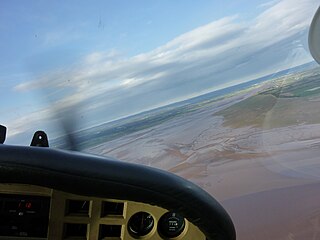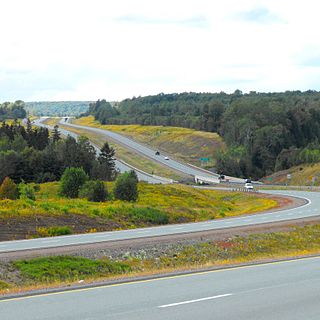
The Cobequid Mountains, [1] also sometimes referred to as the Cobequid Hills, is a Canadian mountain range located in Nova Scotia in the mainland portion of the province.

The Cobequid Mountains, [1] also sometimes referred to as the Cobequid Hills, is a Canadian mountain range located in Nova Scotia in the mainland portion of the province.
Geologically, the Cobequid Mountains are considered part of the Appalachians. The range stretches from Cape Chignecto in Cumberland County in the west through to Pictou County in the east.
The Cobequid Mountains trace their geologic history to the Precambrian and Devonian ages; consequently the mountains are composed of a combination of sediments, granites, and volcanic rock all of which has been crushed and folded by continental drift when this part of Nova Scotia was located at the centre of the Pangea supercontinent. Subsequent erosion over millions of years has resulted in the present-day low range of mountains and rolling hills.
The part of northern Nova Scotia which contains the Cobequid Mountains is believed to have been linked with what is now northern Europe. Its collision with a section from present-day northern Africa has resulted in the current landscape in the province; a remnant fault line from this event, the Cobequid-Chedabucto Fault, extends along the southern portion of the Cobequid Mountains, immediately north of the Minas Basin and Cobequid Bay east to Canso.
Some mistakenly consider the Cobequid Mountains to extend into Antigonish County further east, however this smaller range is geologically distinct and is named the Pictou-Antigonish Highlands.
The highest point of the Cobequid Mountains is an unnamed peak on the eastern side of the Wentworth Valley (365 m (1,198 ft)). [2] Other high peaks include Higgins Mountain (364 m (1,194 ft)), Nuttby Mountain (360 m (1,181 ft)), Dalhousie Mountain (335 m (1,099 ft)), and Mt. Thom (329 m (1,079 ft)).
The range contains an abundance of freshwater lakes and some springs which form headwaters that flow via a number of small rivers and streams south into the Minas Basin and north into Northumberland Strait. Several escarpments associated with the Fundy Basin have been formed from fault lines, resulting in a number of waterfalls on the southern mountain slopes.
Forests covering the Cobequid Mountains are mainly of hardwood species sugar maple (also known locally as 'rock maple') and yellow birch on mountain slopes, which present spectacular displays in autumn with the changing of the colours. Steep stream and river valleys are dominated by red spruce stands. The lower slopes consist of balsam fir, red spruce, black spruce, white spruce, paper birch, red maple and silver maple (also known locally as 'white maple').
The sedimentary deposits in the Cobequid Mountains hold several coal deposits in various basins, stretching across the northern slope of the mountains in Cumberland County (from Joggins through River Hebert to Springhill) and on the southern edge at Debert. Igneous rocks yielded iron ore at Londonderry. [3]

The Bay of Fundy is a bay between the Canadian provinces of New Brunswick and Nova Scotia, with a small portion touching the U.S. state of Maine. Its extremely high tidal range is the highest in the world. The name is likely a corruption of the French word fendu, meaning 'split'.

The Appalachian Mountains, often called the Appalachians, are a system of mountains in eastern to northeastern North America. The Appalachians first formed roughly 480 million years ago during the Ordovician Period. They once reached elevations similar to those of the Alps and the Rocky Mountains before experiencing natural erosion. The Appalachian chain is a barrier to east–west travel, as it forms a series of alternating ridgelines and valleys oriented in opposition to most highways and railroads running east–west.

Springhill is a community located in central Cumberland County, Nova Scotia, Canada.

The Minas Basin is an inlet of the Bay of Fundy and a sub-basin of the Fundy Basin located in Nova Scotia, Canada. It is known for its extremely high tides.

Cobequid Bay is an inlet of the Bay of Fundy and the easternmost part of the Minas Basin, located in the Canadian province of Nova Scotia. The bay was carved by rivers flowing into the eastern end of the Bay of Fundy.

Londonderry is an unincorporated community located in Colchester County, Nova Scotia, Canada, formerly called Acadia Mines. A bustling iron ore mining and steel making town of some 5,000 in the late 19th century, the population today stands at around 200.
Alexander McNutt was a British Army officer, colonist and land agent, responsible for seeing an approximate 500 Ulster Scottish emigrants arrive in Nova Scotia during the early 1760s.

The Chignecto-Central Regional Centre for Education is a Canadian public school district in Nova Scotia.
Trunk 4 is part of the Canadian province of Nova Scotia's system of Trunk Highways. The route runs from Highway 104 exit 7 near Thomson Station to Glace Bay. Until the construction of the Trans-Canada Highway, Trunk 4 was a major traffic link in northern Nova Scotia and Cape Breton, and is still used on Cape Breton as an alternative to Highway 105. The highway was originally called the King's Highway, however, this name is no longer applied to the entire road. The only remaining historic section of the highway that maintains the name "King" is King's Road in Sydney.
The Glooscap Trail is a scenic roadway in the Canadian province of Nova Scotia.

The Nova Scotia peninsula is a peninsula on the Atlantic coast of North America.

The New England-Acadian forests are a temperate broadleaf and mixed forest ecoregion in North America that includes a variety of habitats on the hills, mountains and plateaus of New England and New York State in the Northeastern United States, and Quebec and the Maritime Provinces of Eastern Canada.

Cape Chignecto Provincial Park is a Canadian provincial park located in Nova Scotia. A wilderness park, it derives its name from Cape Chignecto, a prominent headland which divides the Bay of Fundy with Chignecto Bay to the north and the Minas Channel leading to the Minas Basin to the east. The park, which opened in 1998, is the largest provincial park in Nova Scotia. It also anchors one end of the UNESCO Cliffs of Fundy Global Geopark.

Cape Chignecto is a headland located on the Bay of Fundy coast of the Canadian province of Nova Scotia.

The Cobequid Pass is the name given to a 45 km (28 mi) tolled section of Nova Scotia Highway 104 between Thomson Station, Cumberland County and Masstown, Colchester County in the Canadian province of Nova Scotia. The section is a public–private partnership; the highway is owned by the Highway 104 Western Alignment Corporation, a Crown corporation of the Government of Nova Scotia, with a toll plaza operated under contract by Atlantic Highway Management Corporation Limited, a subsidiary of Aecon Concessions. The toll plaza is located near the halfway point in Londonderry.
The Chedabucto Fault is a fault that divides Mainland Nova Scotia from the Minas Basin in the west to Chedabucto Bay in the east into the Avalon zone in the north and the Meguma Zone in the south. The Avalon and Meguma Zones are different because they belonged to different land masses that were widely separated from one another. The Avalon Zone was a part of Laurasia, while the Meguma Zone was a part of Gondwana. It marks the southern margin of the Cobequid Mountains. The Cobequid-Chedabucto Fault Zone is the most prominent geological feature of Nova Scotia.

Uisge Ban Falls is a waterfall near Baddeck, Nova Scotia, Canada. The falls is located in Uisge Ban Falls Provincial Park near New Glen, Victoria County, 14.5 kilometres north of Baddeck.

Uisge Ban Falls Provincial Park is a provincial park near New Glen, in the Canadian province of Nova Scotia on Cape Breton Island. Located on the North Branch Road 14.5 kilometres (9.0 mi) north of Baddeck, the civic address of the park entrance is 715 North Branch Road, Baddeck Forks, Nova Scotia, Canada B0E 1B0

The following outline is provided as an overview of and topical guide to Nova Scotia: